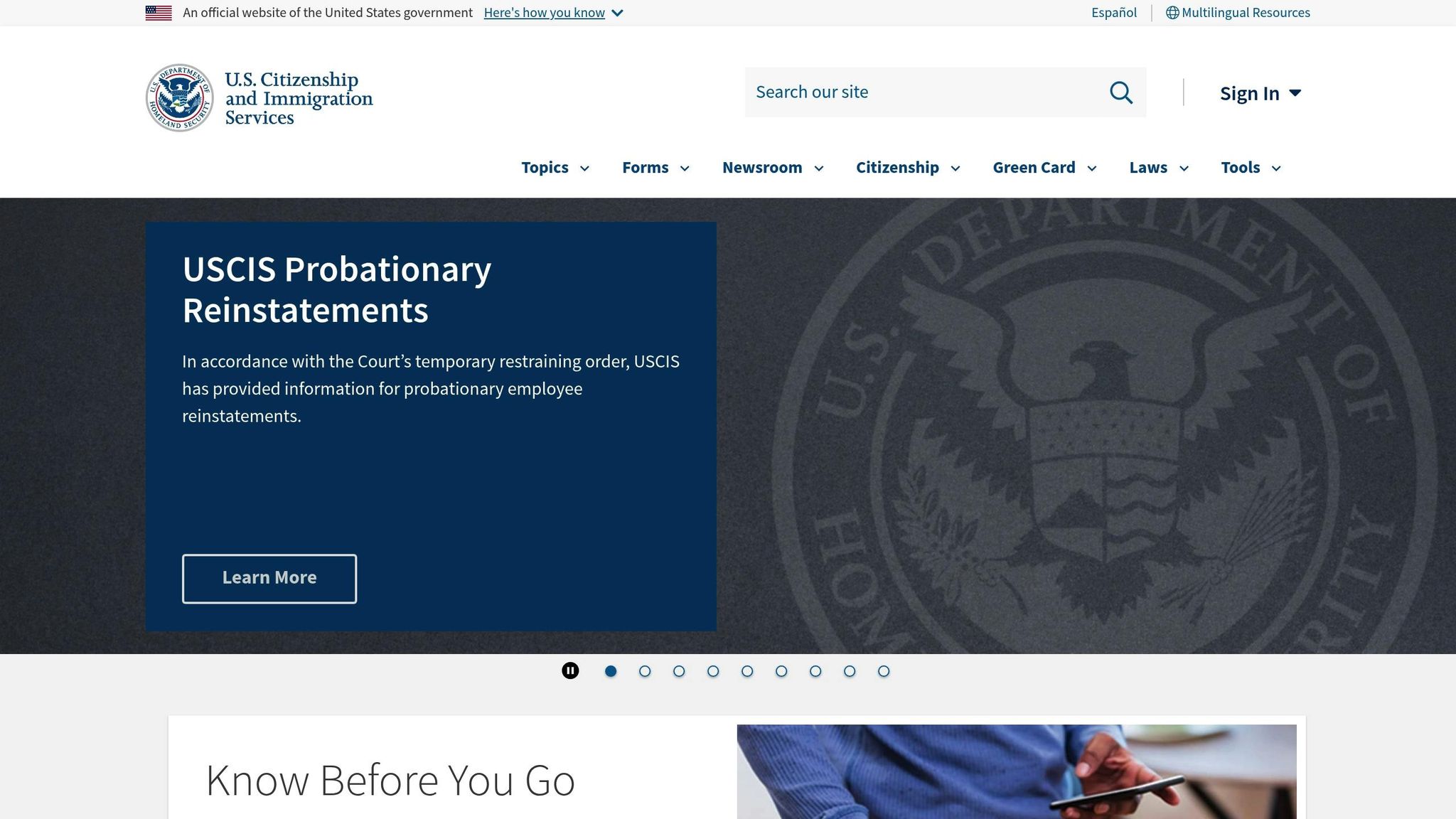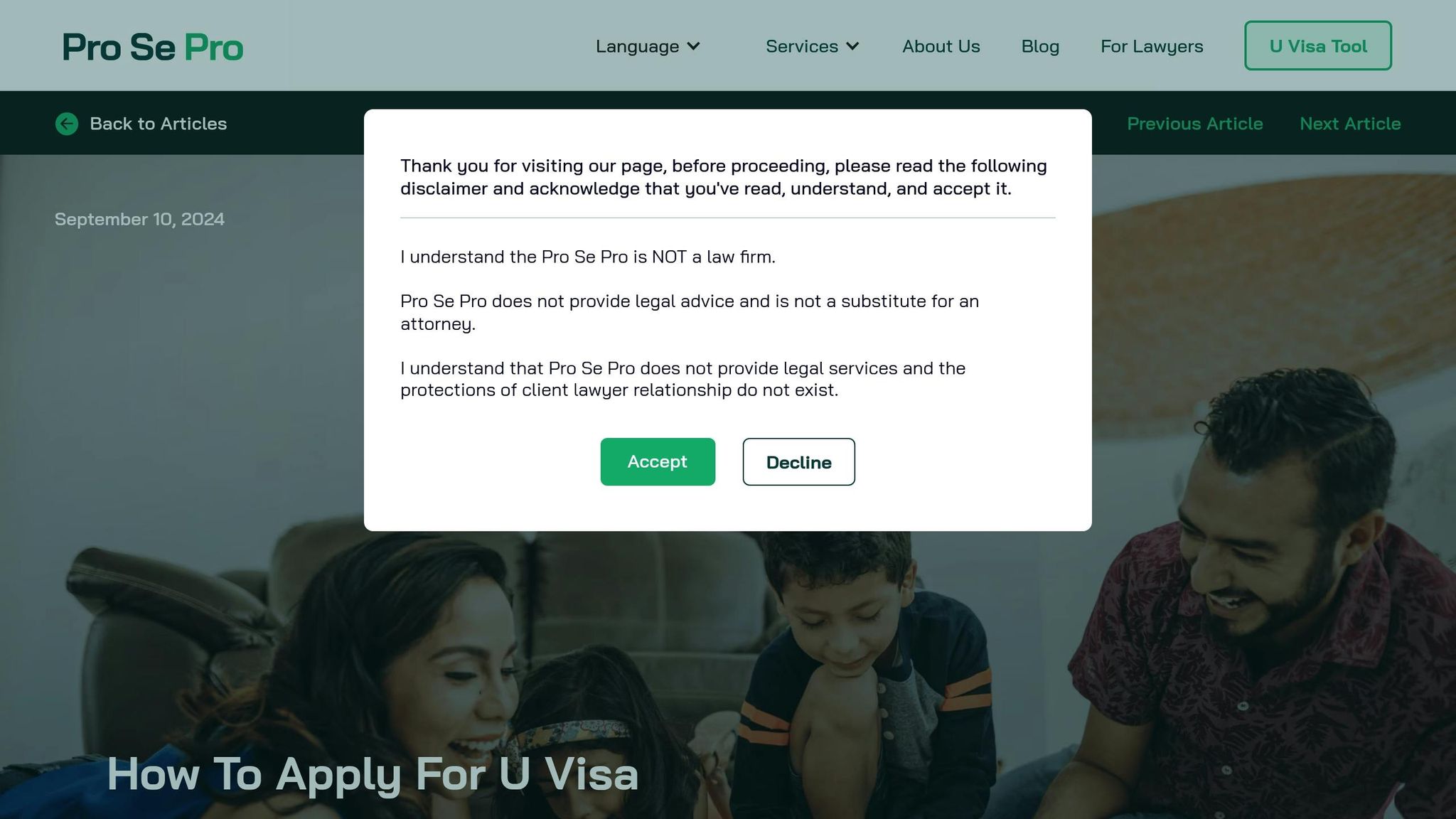
U Visa Processing Times

Waiting for a U Visa? It takes time - here’s what you need to know.
- Processing Time: As of March 2025, it takes about 51 months (4+ years) for USCIS to process Form I-918, with full application approvals taking 6-8 years.
- Why the Delay? There’s a yearly cap of 10,000 U Visas, leading to backlogs. Requests for Evidence (RFEs) and legislative issues can also slow things down.
- What’s New? USCIS introduced the Bona Fide Determination (BFD) process to speed up benefits for eligible applicants.
Quick Tips:
- Track your case online at uscis.gov.
- Respond quickly to RFEs to avoid further delays.
- Consider expedite requests for emergency or humanitarian reasons.
These steps can help you stay informed and manage the long wait times.
2025 U Visa Wait Times
Average Processing Length
As of March 2025, the processing time for U visas remains lengthy. USCIS is currently handling Form I-918 applications filed roughly 51 months ago. Each step in the process - starting from the initial review to the final decision - faces its own delays. Several factors contribute to these extended timelines:
Common Delay Causes
- Annual Visa Cap: Federal law limits the number of U visas issued each fiscal year to 10,000, creating a backlog. Even approved applicants often have to wait for a visa number to become available.
- Request for Evidence (RFE): If USCIS requests additional documents, the process can pause temporarily. These requests often involve missing police certifications, incomplete medical records, or inadequate proof of cooperation with law enforcement.
- Legislative Issues: Delays in reauthorizing the Violence Against Women Act (VAWA) have, at times, slowed USCIS operations, further impacting processing efficiency.
New USCIS Rules

Recent regulatory updates aim to address some of these delays. The Bona Fide Determination (BFD) process is a notable change, designed to speed up certain parts of the application process and provide earlier access to benefits for those who qualify.
"Recent changes in the way U.S. Citizenship and Immigration Services (USCIS) processes U nonimmigrant visas make it difficult to know how long it may take."
– New Frontier Immigration Law
"The amount of time necessary for USCIS to make a decision on your U visa application will vary depending on the details of your case, but expect major delays."
Some of the steps being implemented to manage wait times include:
- Dedicated Processing Centers: Applications are now handled at two specialized locations, the Nebraska and Vermont Service Centers.
- Deferred Action Status: Applicants awaiting final visa numbers may qualify for deferred action, allowing them to remain in the U.S. while they wait.
🚨 USCIS Processing Time Update – January 2025 🚨
Check Your Case Status
With long wait times, staying on top of your U Visa application is crucial. Tracking your case online helps you stay updated on its progress.
How to Check Your Case Status Online
- Step 1: Go to the official USCIS website: uscis.gov.
- Step 2: Find your receipt number on any notice from USCIS.
- Step 3: Enter your 13-character receipt number in the Case Status Online tool. (This number starts with three letters like EAC, WAC, LIN, SRC, NBC, MSC, or IOE, followed by 10 numbers. Include asterisks if present, but leave out dashes.)
- Step 4: View the latest updates on your case, including recent actions and any next steps.
These steps give you a quick overview of your case's progress.
Ways to Stay Updated
The USCIS online system offers status updates that highlight recent actions and outline what to do next. You can stay informed through two main options:
-
Create a USCIS Account:
With a free account, you can:- See detailed updates, including the last five actions on your case.
- Manage multiple applications in one place.
- Access electronically submitted documents.
-
Use the Case Status Online Tool:
Regularly check for recent updates and any required actions to ensure you're on track.
sbb-itb-21a8261
Handling Long Wait Times
Long U Visa processing times can be tough to deal with. Here’s how you can navigate the delays effectively.
Staying Updated During the Wait
Extended wait times can be overwhelming, but staying on top of USCIS communications is key. Regularly check for updates and consider pursuing interim work authorization if eligible.
Applying for Work Authorization
If you're waiting for your U Visa, you might qualify for work authorization. Here’s how to proceed:
- Check Eligibility: Confirm if you meet the requirements for work authorization. If you're unsure, seeking expert advice can help.
- Submit the Necessary Forms: Ensure all forms are completed accurately, and keep copies for your records.
- Track Your Case: Use your USCIS account to monitor any updates or changes to your application.
Responding to RFEs
If USCIS requests additional documentation, follow these steps to handle it efficiently:
- Understand the Request: Carefully read the Request for Evidence (RFE) and note the submission deadline.
- Prepare the Documents: Collect all necessary documents, making sure they are current and properly translated.
- Submit Everything Correctly: Include all requested materials along with a cover letter that references your case number.
"Respond promptly to any Requests for Evidence (RFEs) from USCIS, as these can put a hold on your file until the requested documents are submitted".
Keep your contact information up to date with USCIS to ensure you receive all critical updates about your case.
For additional support, Pro Se Pro provides guidance on managing U Visa delays and exploring ways to expedite your application. Their expertise can help you stay proactive and ensure your application remains on track while awaiting a decision.
Speed Up Your U Visa
With the long wait times often associated with U Visa applications, here are some practical steps to help move your case along.
File an Expedite Request
USCIS allows expedite requests for U Visa cases, typically for Bona Fide Determination or Waiting List Placement. Here’s how to proceed:
-
Check Eligibility
You may qualify for an expedite request if you meet certain criteria, such as:- Severe financial loss
- Emergency situations
- Humanitarian reasons
- Government interests
- A clear error by USCIS
-
Submit Your Request
- If you have an attorney, they can email the appropriate service center on your behalf.
- If you’re handling your case yourself, you can either schedule an appointment at your local USCIS field office or send a written request.
- Law enforcement agencies can email LawEnforcement_UTVAWA.VSC@uscis.dhs.gov.
Only submit one expedite request to avoid unnecessary delays.
Keep Your Information Up to Date
In addition to expedite requests, maintaining accurate contact details is crucial to avoid setbacks in processing. Here’s what to do:
- Update your address using Form AR-11 within 10 days of moving.
- Ensure your phone number and email are correct in your USCIS account.
- Keep copies of all update confirmations for your records.
- Regularly check your case status through your USCIS account.
Reach Out to Congress
If your application still isn’t progressing, you can seek help through congressional channels:
- Find your representative using the U.S. House of Representatives website.
- Email the district office of your representative.
- Complete the required privacy waiver form.
- Provide detailed information about your case.
Involving your congressional representative can draw attention to delays and potentially accelerate your case.
Pro Se Pro offers expert assistance in expediting U Visa applications, guiding you through legal options to help ensure your case is processed as efficiently as possible while meeting USCIS requirements.
Next Steps
Now that you know how to track and support your application, here’s how to manage and speed up your U Visa process.
Key Points to Remember
USCIS recently shifted from a waitlist system to the Bona Fide Determination (BFD) process, which changes how applications are reviewed. To stay on top of your case:
- Monitor your status: Use the USCIS online portal, check your email and postal mail regularly, and keep all correspondence in a safe place.
- Address delays: If your case takes longer than standard processing times, submit a USCIS inquiry.
Pro Se Pro Services

If you’ve tried these steps and still need help, Pro Se Pro offers specialized U Visa support. Their services focus on overcoming common delays and documentation issues. On average, clients report receiving responses in about 43 days.
Here’s what Pro Se Pro provides:
- Step-by-step guidance through a detailed video course and playbook
- Help with expediting work authorization requests
- Support for document preparation and submission
- A money-back guarantee if no government response is received within 60 days (note: a $402 processing fee and postage are non-refundable)
This service is designed to give applicants the tools they need to manage their cases effectively, without the high costs of hiring a lawyer.
Related Blog Posts

Stop Waiting On The USCIS



.avif)
